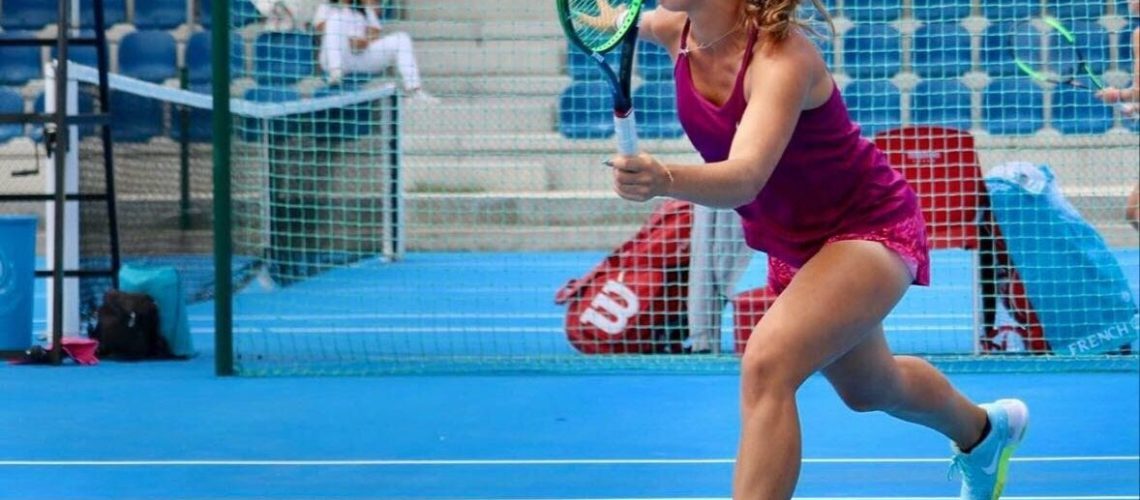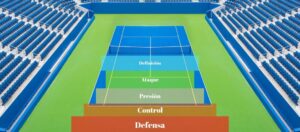It is curious that sometimes, throughout the learning process, the most valuable details remain on the way without being noticed. One of them is THE CENTER. Even players who are part of the semi-professional world very often stare at me with wide eyes when I ask them about it. Where do you think your center is if you play a crosscourt, down the line, or the middle of the court? The normal answer is: silence or the center of the court. That is why, already playing at high levels, those same players are pressured in an incomprehensible way (for them) without their shot, or their fitness being worse than those of their opponents.
On the Baseline
Throughout this article we will discuss the issue that may seem like a piece of cake in the end, but the real difficulty is that these displacement schemes have to become instincts and adapt to the variety of your opponents.
Basic schemes
We will start by remembering a bit of plane geometry:
- Definition of bisector: The bisector of an angle is the line that passing through the vertex of the angle divides it into two equal angles.
- The points of the bisector verify an important property: Each point of the bisector is at an equal distance from the lines (or rays) that define the angle.
Taking these two points as a basis, we can already start talking about how to adapt them to tennis. First, what do we call an angle on the court? You usually hear: open the angle, or close the angle. But what does each one of them mean?
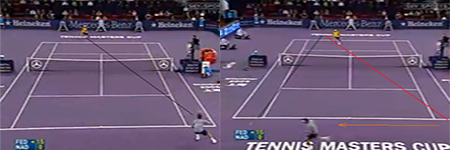
- OPEN THE ANGLE: direct the ball to either side of the court to displace the opponent and open the gap. That blow can be seen as one of the sides of the spoken angle.
- CLOSE THE ANGLE: once the first phase has been executed, direct the ball to the other side, thus building a geometric angle. The more the opening, the more chances to win the point.
That angle is what we are going to talk about and in the case of choosing the center, we will always see it as two possible shots to the opponent. On each shot, your opponent will have those two extreme possibilities, including a wide variety of shots.
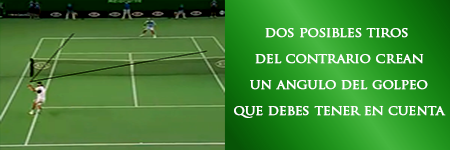
We are going to see in this section lateral displacements and their center. The vertical displacement must also be taken into account: the height at which you must be located, but we will see this in one of the next articles “Zones of the court”. You will also have to pay attention to the particularities of your opponent’s shots and adapt the basic diagrams to special situations.
Your center changes depending on the position of the ball on the court. The center is almost never, and I repeat, never in the center: the first thing to know is: you have to place yourself on the bisector of the possible hitting angle of your opponent. The following photos will give you clues to guide you visually. So:
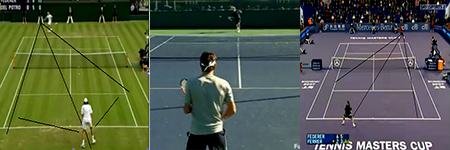
- If you play to the opponent’s right, the center will shift to the right side.
- If you play to the opponent’s left, you will have to move further to the left.
- And if you play in the middle, you will position yourself by opening up a little more space for your longer lever side. That means if you are right-handed, you will go half step to the left. And the opposite for left-handers.
Then comes the topic of your movement towards the ball. The optimum would be to go at a right angle of it’s trajectory, which means, as seen in the photo, CUT ANGLE, enter. Running on the baseline or going back to get to the ball is a very common mistake. (Note the second geometry point at the beginning.)
All this is seen in a different way when playing. The pressure or the lack of technical facility leads you to the illusion forcing the opposite to what has been said. I would advise you to do simple geometric calculations to convince yourself a little more and start working on it.
Adapting to your opponent’s personality
In addition to what was said previously, you have to study the player on the other side. If he has a very open crosscourt shot, or plays down the line very comfortably. If he doesn’t not dare to hit a backhand down the line or does it without much precision. This and much more you have to know at the beginning of the match or find out as soon as possible. There are also cases where your opponent loses confidence in his best shot and, despite the mistakes made, keeps trying.
That’s why you have to remember: your center is never fixed on the court, and in addition to being on the bisector of your opponent’s possible shooting angle, it can vary depending on the particularities of the shots. You have to take into account the variations of these possibilities of the shots and adapt to them.
Tactical and strategic uses
How to take advantage of all this in your placement schemes? I will give you some examples:
1.
You have worked many times your running forehand and you have confidence in it. You see that the other player is not very good at the backhand down the line. What do you do? You slightly change your center leaving more room for your right side, you open up even more, thus inviting your opponent to hit an uncomfortable shot for him: backhand down the line. He does it. There are three ways how the situation can be resolved:
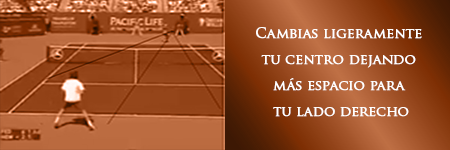
- He misses because he has taken too much of a risk being deceived to have seen the empty court.
- He secures the shot too much and leaves an easy ball for your comfortable shot: running forehand.
- He takes a risk and comes out with a pretty good winner. In this case you do not have to hesitate to repeat the move, with more caution, if you are sure that this is his weak side.
2.
You see that the player recovers badly after hitting down the line. You give him the facility to execute that shot, waiting for it and taking advantage of his bad recovery you are there to pressure him.
3.
You notice the advantage of playing more crosses than down the line shot for the simple fact that the distance to recover to the center is shorter.
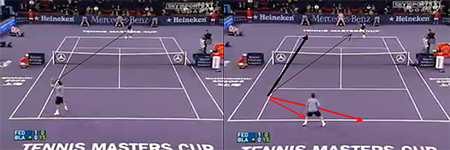
4.
The same on the defensive ball, or playing from way outside of the court, you choose a suitable shot to recover on time.
5… 6… 7… and many more details, of which you will already be doing some without realizing it.
In the end, I would like you to pay attention to the article “Three points of vision” in order to coordinate it with what was said above.
At the net

Above we have talked about your center on the court at the baseline, about its basics and how to take advantage of it. Now we are going to focus on the volley. How to cover the net in the best possible way? Although in the current tennis elite you will not see matches similar to those of Rafter, Sampras, Edberg or Becker, due to the speed of the game that leaves very little time to go up, even so, in other levels, to dominate this part of the game has quite an advantage.
The idea of looking for your center at the net is the same as on the baseline: you have to place yourself at the bisector of a possible angle of the shots of your opponent. And that line passes, this time, on the same side of the center where the ball is hit. This is why it is said: cover the line. Really what is meant by this is that visually a player is deceived and always leaves the down the line option more open. This happens for several reasons:
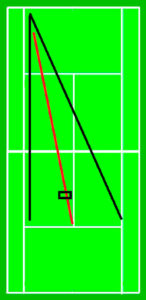
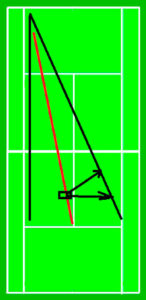
- Instead of anticipating the ball and going for it, when it is closer to the center of the court, the player waits for it … and of course, the ball moves further and further apart. Remember what is the shortest distance to the sides of the angle.
- To be able to anticipate and coordinate your footwork with the ball, you need to do a split-step (see the article “Three points of vision”. In addition, the ball comes faster at the net than on the baseline, so this point is important enough to cover the net.
- And finally, (this mistake is identical at the baseline too) forget the lines and don’t run thinking about them! The lines are there for some reason, but they are in no way there to give you directions of mobility. Imagine a court without lines and now imagine a crosscourt. How would you intercept it? It would be funny to see it. Don’t you agree? And that way of intercepting is called: cutting the angles.
There is another important point, which we will discuss in next articles, which is the height of the court at which you must find the center. Because you have to go ahead to cut the angles you will need that space between you and the net. So if you get too close to the net, you will give your opponent a good chance to pass you, if you stay too far from the net, the distance to the ball gets long. ¾ of the height of the service box is the average that varies depending on previous shots and moves.

There are many more topics that we should talk about in order for your net game to be effective: the steps, the approach, the point building, some tricks of the physical training, etc. And each of them will appear in the next articles. But remember that the best way to feel comfortable up there is to simply go up to the net, go up every time you have the slightest opportunity and I assure you that in few months you will become a good net player for your level.




